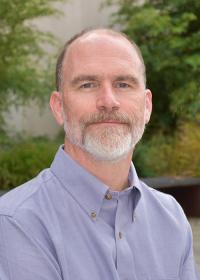Patrick Heagerty once co-authored a paper on vertebroplasty, a procedure where a cement-like glue is injected into vertebrae to relieve pain. “It didn’t work any better than a sham injection,” says Heagerty, professor and chair of biostatistics.
That study made a significant impact, he says, and the once-common procedure dropped in popularity.
More recently, Heagerty co-authored an article in the New England Journal of Medicine that showed epidural steroid injections in patients suffering from lumbar stenosis offered no more relief from pain than injections of lidocaine, a local anesthetic.
“I’m good at collaborating on negative studies,” says Heagerty, laughing. “But negative is important in this space because this is something we do all the time (epidural injections). So why are we doing it all the time? We’re wasting money and potentially putting patients at risk.”
Learning from things that unfold over time is a theme throughout Heagerty’s work.
“When you collect data over time, you get to see change,” he says. “Seeing change allows you to correlate that change with other things, like a change in exposure or a condition that you have. My initial focus was longitudinal data – multiply measured outcomes such as pulmonary functions or other health-status measures.”
Heagerty also studies biomarkers that may predict clinical events such as the onset of disease and even death.
“We want to make those predictions so we can make actions,” he says. Someone at high risk for death, for instance, might be placed higher on a list for a liver or lung transplant. Heagerty’s work centers around questions such as, “How do we evaluated those predictive models? How good are they at what we want them to do – finding people who need to be found?”
Heagerty brings his core methodologies in longitudinal data to different public health and medical domains, including back pain. A long-standing collaboration with Jerry Jarvik (UW professor of radiology, health services, and neurology) involved Heagerty in back pain research and led Heagerty to run the Center for Biomedical Statistics within the Department of Biostatistics. The center conducts trials in a number of areas, including neonatology, depression and nephrology, and rehab trials.
In addition to research, Heagerty’s new role as chair of the department is to maintain strong collaborations with research partners in Seattle, including the UW Department of Statistics, the Fred Hutch, Group Health Research Institution, the local public health department, and other investigators in the Schools of Public Health and Medicine.
Heagerty still finds time to teach and enjoys mentoring junior faculty and students. “At this point of my career, I really like to build the career of junior faculty,” he says. He received an Outstanding Teaching Award from the School of Public Health.
One of his mentees, graduating PhD student Leila Zelnick, says Heagerty gradually “takes the training wheels off” until his students feel like full-fledged researchers.
After graduating from college, Heagerty taught math, biology and science to middle- and high-school students in New York state for a couple of years. “Through that, I really wanted to put math and biology together,” he says. “So I did a PhD in biostatistics. Biostatistics in a way really does merge passion and skill and both biomedical science and mathematics and statistics,” he says.
Originally from upstate New York, Heagerty now lives on Vashon Island, across Puget Sound from Seattle. He takes the ferry on his bicycle, cycling from the ferry terminal in downtown Seattle to the UW campus. “It allows me to live in the country,” he says, “but I work in the city and I can sneak into the city anytime I want.”
Patrick Heagerty is a professor of biostatistics and former chair of the Department Biostatistics at the University of Washington. He has a PhD in Biostatistics from Johns Hopkins University, an MS in Statistics from State University of New York, and a BS in Biology from Cornell University. He is a member of Fred Hutch Research Center, Director of Center of Biomedical Statistics, and a fellow of the American Statistical Association.
